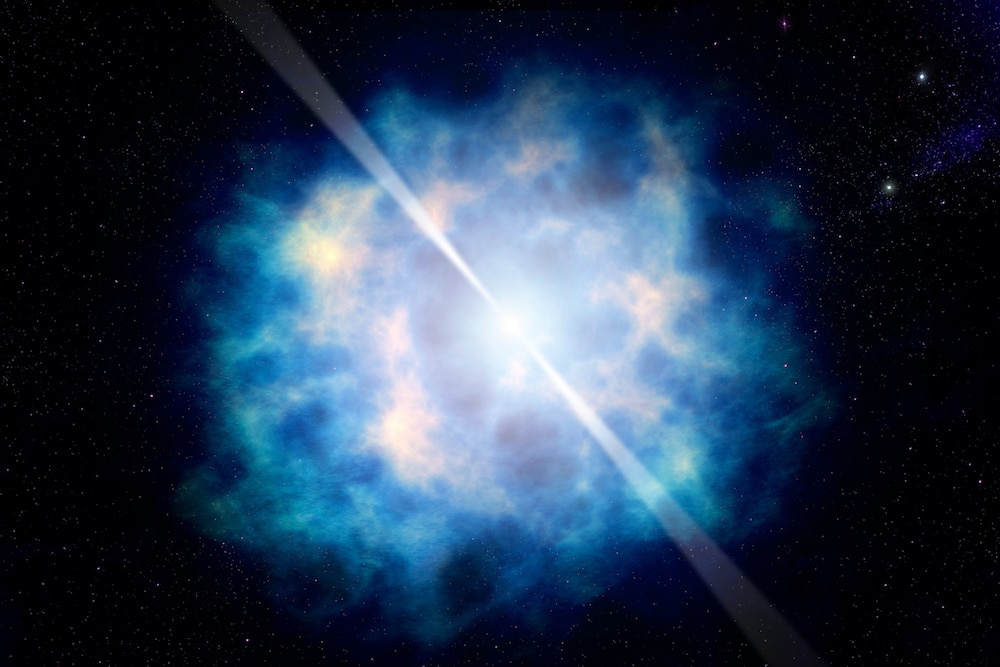Create a free profile to get unlimited access to exclusive videos, sweepstakes, and more!
There’s gold in them thar colliding neutron stars
Grab your pickaxe and space ship!

The Earth, and even our own bodies, are filled with elements produced out in space before the world was made. Fusion inside the center of stars is largely responsible for the production of the lighter elements. As stars go through the phases of their life cycle, they create heavier and heavier elements, but they hit a hard stop once they produce iron. Fusing elements heavier than iron requires more energy than stars are capable of.
That’s left an open question in the scientific community regarding where heavy elements come from. We know they exist, and we know they must be produced as a biproduct of cosmic events, but nailing down their origin has been a challenge.
A new study published in the Astrophysical Journal Letters suggests that binary neutron star collisions could be the primary source of gold and other heavy elements in the universe.
A number of violent events have been suggested, including supernovae and the merger of massive objects in space. Scientists hypothesized that the collision of two neutron stars, or the collision of a neutron star with a black hole, might spit out heavy elements, making these collisions a good candidate for the birthplace of elements heavier than iron.
These elements are known as r-process (rapid neutron-capture process) elements. They’re built when nuclei are bombarded by a whole lot of neutrons all at once, something which can happen during violent cosmic events.
In 2017, scientists observed the collision of two neutron stars which had been circling one another for billions of years. The collision sent a gravitational shockwave through space and those waves were picked up by the Laser Interferometer Gravitational-Wave Observatory (LIGO). Scientists at LIGO sent out the call to other astronomers to aim their telescopes at that point in the sky, and they saw a new point of light which started out blue and faded to red. It was the explosive debris of the collision.
After a day, the debris cloud was the size of a solar system and filled with heavy elements. Astronomers estimated this one collision created enough gold to equal hundreds of Earth masses, and even more platinum.
This event confirmed that neutron star collisions were indeed a source of heavy element production. The question then became how those collisions compared to the collision of a neutron star with a black hole. Researchers estimated they might see similar heavy-element ejections if the neutron star-black hole reaction was such that the black hole disrupted the star before it was swallowed.
To find out what might be happening, scientists modeled these collisions, taking into variable masses and spins, and ran 100,000 simulations to estimate the amount of material ejected by the collisions. They found that most of the mass ejected from these events should become heavy elements, but the amount of mass ejected was highly dependent on the qualities of the objects colliding.
They landed on two possible outcomes. If the mass of a black hole is small, less than 5 solar masses, or if the spin of the colliding objects is aligned, the mass ejected is substantial. Under this scenario, 77% of r-process heavy element production can be explained. The second scenario is that most black holes are too large or have undesirable spins, and the majority of heavy elements are created in binary neutron star collisions. Both scenarios can create an accretion disk full of heavy elements which quickly become unbound from the collision site.
But because black holes which are too large (larger than 5 solar masses) or which don’t have the right spin swallow neutron stars before they can toss their cosmic baggage, the relative contribution of heavy element production is dependent on how frequent each collision type is, as well as the masses and spins of the colliding objects.
Based on available gravitational wave observations, the low-mass black hole scenario isn’t favored. Instead, the data suggests that most black hole-neutron star mergers end in swallowing and little if any heavy element production.
The more likely scenario is the one observed by LIGO in 2017, that heavy elements are largely produced during the collision of two neutron stars. There are still plenty of missing puzzle pieces for astronomers to chase down. The current study is limited to the past 2.5 billion years as the observations have been largely local. And there’s still the question of other high-energy cosmic events and what portion of heavy element production they’re responsible for.
Regardless, if there’s another gold rush, it will likely happen around circling neutron stars.


























